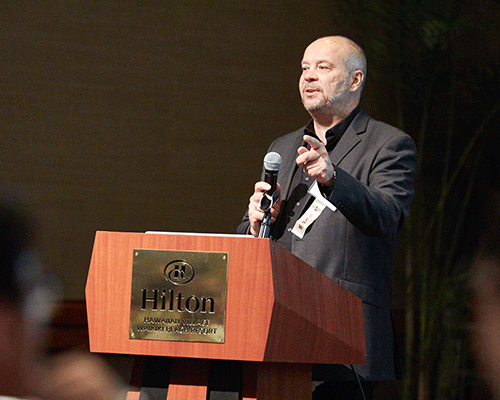
Dr. Robert Kostecki
Topic Area Leader
Dr. Jeff McCutcheon
Deputy Topic Area LeadThe Challenge
Materials development and fabrication methods for desalination systems are largely empirical and heuristic[i],[ii], failing to fully leverage molecular-level structure-property relationships in the design of interfaces, bulk materials, or 3D material architectures, and component designs. This heuristic approach can lead to long materials development cycles; materials innovations that are disconnected from process constraints; and single-attribute optimization of materials systems or components for either performance, robustness, or manufacturability[iii].
Our Approach
Radical improvements in desalination system performance are possible by leveraging new computational and experimental tools for predictive simulations, rapid screening, and multi-objective optimization of materials functionality. In doing so, we will focus desalination materials research on high-value-proposition materials innovations.
The objectives of the materials and manufacturing research and development (R&D) topic area are to (1) develop new high-throughput gradient synthesis and computational simulation and screening tools to accelerate the materials discovery and design process for water desalination; (2) advance manufacturing technology and metrology to accelerate the adoption of new materials in water desalination systems; and (3) characterize materials performance in operando to enhance the scientific understanding of their basic function, operation and relationship between their physicochemical properties and performance in desalination systems.
We draw on state-of-the-art high-throughput computational tools, experimental facilities, sensing platforms, and manufacturing demonstration facilities at DOE national labs, DOE Basic Energy Science Energy Frontiers Research Centers (EFRCs), National Science Foundation Engineering Research Centers (ERCs)and other unique resources in the NAWI network. R&D in these new materials will be validated under realistic conditions in industrially relevant, integrated systems and provide data or other information in coordinated interface tasks and activities with other NAWI topic areas.
Projects
Project 6.02Machine Learning Platform for Catalyst Design Lead: Anubhav Jain, Lawrence Berkeley National Laboratory
This project will develop a high-throughput computational platform for identifying novel electrode materials using state-of-the-art user facilities at Lawrence Berkeley National Lab that integrates machine learning, high fidelity simulation, and combinatorial experimental screening.
Partners: Electric Power Research Institute, CMU
Project 6.03Omics Platform for in-operando Biological Characterization Systems DesignLead: Pedro Alvarez, Rice University
This project will build a comprehensive omics platform to empower the research community to fundamentally understand biofilm formation and mitigate biofouling in water treatment and distribution systems.
Partners: University of Texas at Arlington, Oak Ridge National Laboratory, DuPont, IDE Technologies
Project 6.04Development of HPRO Membrane Platform for the Desalination of High Salinity Waters Lead: Jeffrey McCutcheon, University of Connecticut
The main objective of this project is to create platform approaches to understanding how membranes behave when exposed to high pressures and salinities.
Partners: Yale, Oak Ridge National Laboratory
Project 6:05Kinetic Modeling and Experimental Validation of Mineralization in High Salinity Brine Solutions with and without Scale InhibitorsLead: Sharon Bone, Stanford University
This team will create a software program to better predict kinetic induction times which may improve capabilities of brine concentrators to operate at the edge of scale formation.
Partners: National Energy Technology Laboratory, Veolia Water Technologies, OLI Systems, Inc.
Project 6.06Engineering Super Antiscalants for High Recovery Brine ConcentratorsLead: Menachem Elimelech, Yale University
This team aims to develop new and improved antiscalants to prevent equipment scaling and improve the efficiency of brine concentrators.
Partners: Oak Ridge National Laboratory, Electric Power Research Institute, Saltworks Technologies
Project 6.07WaterPy: Open-Source Modeling and Optimization Library for Water Treatment ProcessesLead: George Bollas, University of Connecticut
This team will develop a new software toolset for the design and optimization of brine treatment processes.
Partners: Sandia National Laboratories, Modelon, Inc.
Project 6.08Direct electrochemical reduction of selenium to achieve A-PRIME water treatment Lead: Anubhav Jain, Lawrence Berkeley National Laboratory
This project utilizes breakthrough computational techniques to design novel electro-reactive materials that could directly chemically reduce and remove selenium from non-traditional water sources as a pre-treatment step prior to desalination.
Partners: William Marsh Rice University, Auburn University, Stanford University, and Electric Power Research Institute
Project 6.09Selective Separation of Selenium Oxyanions By Chelating Hydrogen-Bonding Ligands Lead: Radu Custelcean, Oak Ridge National Laboratory
This project explores a promising family of chemical compounds that could directly bond to selenium atoms prior to RO for efficient removal of this challenging contaminant.
Partners: Georgia Institute of Technology University, ReactWell, LLC, Tennessee Valley Authority
Project 6.10Porous Polymer Networks and Membranes for PFAS and Selenium Removal from WaterLead: Jeffrey Long, University of California at Berkeley
This project will design novel cage-like molecules that can be modified to selectively bond to specific contaminants in water, focusing on removal of selenium and PFAS, which are problematic constituents in desalination and water reuse systems.
Partners: Electric Power Research Institute, Colorado School of Mines, Colorado Higher Education Competitive Research Authority, and ZOMA Foundation
Project 6.11UHPRO Membrane and Module Design & Optimization Innovations to Enable & Optimize Ultra-High Pressure Reverse Osmosis Membranes Lead: Eric Hoek, University of California at Los Angeles
This project will develop new RO membranes that can withstand the ultra-high osmotic pressures created when desalinating concentrated brines.
Partners: National Renewable Energy Laboratory, Yale University, University of Wisconsin-Madison, and University of Connecticut
Project 6.12Electrochemical Advanced Oxidation Lead: David Sedlak, University of California at Berkeley
This project will create a novel, low-cost electrochemical process for oxidizing and removing organic contaminants from water suitable for pre-treatment prior to RO in distributed treatment and water reuse environments.
Partners: Lawrence Berkeley National Laboratory
Project 6.13Copper Recovery from Mining Process Waters with Ion-Selective ElectrodialysisLead: Rafael Verduzco, Rice University
Copper recovery will help to achieve pipe parity with conventional treatment of mining process waters and/or reuse at copper mines and refineries while simultaneously improving environmental sustainability. The project will also provide platform technology that can be used to develop additional ion-selective cation exchange membranes, targeting other ionic contaminants of interest, such as lead and cadmium.
Partners: The University of Texas El Paso, Magna Imperio Systems Corp.
Project 6.14Novel Bipolar Membrane Assisted Electrosorption Process for the Selective Removal of Boron Lead: Menachem (Meny) Elimelech, Yale University
This project will overcome the persisting inefficiencies in the current state-of-the art boron removal strategies. The research will also provide a demonstration of an effective method for electrosorption of weak acid/base species and selective removal of trace contaminants.
Partners: University of Michigan, Magna Imperio Systems Corp
Project 6.16Redox-Mediated Electrodes for Precision Separation of Nitrogen and Phosphorus OxyanionsLead: Xiao Su, University of Illinois at Urbana-Champaign
Selective electrosorption technologies for the separation and concentration of charged nutrients could enable a sustainable water treatment paradigm, particularly for small communities that struggle to operate centralized facilities and highly sensitive biological removal systems.
Partners: Lawrence Livermore National Laboratory, Oak Ridge National Laboratory, Voltea Inc.
Project 6.17Selective Electrocatalytic Destruction of PFAS using a Reactive Electrochemical Membrane SystemLead: Brian Chaplin, University of Illinois Chicago
This project will overcome technical limitations of existing per- and polyfluoroalkyl substances (PFAS) destruction technologies by improving selectivity for PFAS destruction, minimizing toxic byproduct formation, and limiting short-chain PFAS formation.
Partners: Purdue University, Argonne National Laboratory, M. Davis & Sons Inc., Trimeric Corporation, CDM Federal Programs Corporation, Orange County Water District
Project 6.19Hybrid electrochemical-ion exchange process for selective phosphate recovery as struviteLead: Will Tarpeh Stanford University
This project will use innovation in a new process combining electrochemistry and ion exchange (EC-IX) to address three unresolved challenges faced by state-of-art phosphate recovery technologies: (1) low product yield (e.g., struvite) limited by low phosphate concentration in wastewater; (2) low product purity limited by imprecise separation; and (3) low product uniformity limited by uncontrolled struvite precipitation in wastewater.
Project 6.20Precise Electrochemical Dehalogenation of PFAS in Desalination Concentrates by High Entropy CatalystsLead: Christopher Muhich, Arizona State University
This project will exploit computational approaches to ascertain selective combinations, thus accelerating HEC development and couple it with reactor design construction, both directed by TEA to achieve low-cost, effective halogen removal. To promote commercialization, the project team aims to prove that the Pd-based HEC catalytic system developed in this project is not cost-prohibitive. The investigation of material costs of optimized electrodes, energy consumption, and service life will be the groundwork of techno-economic analysis.
Partners: Clarkson, CDM Smith, Square One, Tetra Tech, Trussell Tech.
Project 6.21Controlling the Effects of Antiscalants on the Nucleation of Highly Soluble Salts in Reverse Osmosis ConcentrateLead: Young-Shin Jun, Washington University in St. Louis
This project team will systematically examine how antiscalants regulate the nucleation and crystallization of highly soluble salts. Based on the obtained fundamental knowledge, the team will develop a predictive model of ROC treatment systems. To promote salt nucleation in brine crystallizers, the team will also design a new electrochemical approach that controls local pH and degrades antiscalants.
Partners: Argonne National Laboratory, Colorado State University, Clarkson University, OLI Systems, Element Six, Public Utilities, City of Clearwater, FL, Bureau of Reclamation, Swenson Technology, National Energy Technology Laboratory, SLAC National Accelerator Laboratory
Project 6.24Development of a Flow-through Intensified ELectroDialysis (FIELD) system to manage inland reverse osmosis concentrateLead: Shiqiang Zou, Auburn University
This project brings together theoretical material scientists, electrochemical scientists and engineers, environmental engineers, energy research organizations, and at-stake inland municipalities to develop a Flow-through Intensified ELectro-Dialysis (FIELD) System. Such a FIELD system strategically combines flow-through electrochemical redox processes with a commercial electrodialysis to degrade recalcitrant organics, capture diluted heavy metals, extract non-hazardous dissolved salts into a clean concentrate for potential environmental discharge, and produce freshwater for beneficial reuse.
Partners: Electric Power Research Institute, Lawrence Berkeley National Laboratory, Rice University, Water Tower
